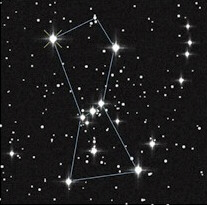

All the sky is divided into 88 constellations, by international agreement. (This is a fairly recent categorization, the early astronomers who named them weren't quite so neat). Some are obscure, others are very easy to see. My favorite is Orion, the Hunter (at right) which dominates the winter sky. Of particular interest are the 12 constellations which make up the Zodiac. These lie along the ecliptic and more or less mark the twelve months of the year. The Greeks pictured the constellations (and the stars from which they were formed) as lying on a huge crystalline sphere. These were the "fixed" stars, not because they didn't move, but because they didn't move relative to each other. a link to the constellations can be found here.
As we move around the Sun our view of the night sky changes until, in the course of a year, we have seen a 360 degree sweep of the heavens. As the different patterns of stars came into view, the ancients were able to associate them with the different seasons. Anyone with the ability to predict the coming of the seasons should, at least in the eyes of some, be able to predict other things, such as the outcome of battles. The craft of astrology came out of such beliefs.
We use the concept of the celestial sphere to locate objects in the sky. As is the case of locating a point on the surface of the Earth, you need a reference point from which to make your measurements, and a grid of lines to mark the position of your objective relative to the reference point. Since the surface of the Earth and surface of our celestial sphere are both two dimensional, only two coordinates are required to locate any point. The Earth's coordinates lie on the surface of the Earth and consist of lines of longitude (great circles which pass through the poles), and lines of latitude (circles centered on and perpendicular to the Earth's axis). The reference point (i.e. the origin of the coordinate system) is the point where the Earth's equator (the line of 0 degrees latitude) intersects the "prime meridian" (the great circle of 0 degrees longitude which passes through the Royal Observatory in Greenwich, England).
The celestial coordinate system is essentially the Earth-bound system projected upward: The Earth's equator is projected upward to the celestial equator. Lines of longitude and latitude are also projected upward, but given different names. Longitude lines become lines of right ascension and latitude lines become lines of declination. The only other difference is the origin of the celestial coordinate system. A projection upward of Earth's reference point won't work, because the Earth is always rotating. What is needed is a point fixed to the stars (i.e. to the celestial sphere). The point chosen is the Vernal Equinox, that point in the sky marked by the intersection of the equator and the ecliptic plane on the first day of Spring. All celestial objects are located relative to this point.
Hipparchus divided the stars into groups according to their brightness as seen in the night sky. The brightest stars he called first magnitude, the next brightest group second magnitude, and continued in integer steps to the dimmest he could see, which he labeled sixth magnitude. The scheme of Hipparchus is still used, except that the advent of optical measuring instruments allows a more precise standard. It turns out that the difference between the brightness a first magnitude star and a sixth magnitude star, as labeled by Hipparchus, is about a factor of 100. By modern convention then, we assign a brightness difference of exactly 100 to stars which are assigned magnitudes which differ by 5. A 6th magnitude star is thus exactly 100 times dimmer than a 1st magnitude star. As a result of the imposition of this standard, the magnitudes of some of Hipparchus' stars have been reassigned. In the modern scale, stars of 6th magnitude are still only barely visible, but some the brightest stars have magnitudes less than 1. The modern convention allows the scale to be extended beyond the 6 levels of Hipparchus, so now we label the brightest star Sirius as -1.5, the second brightest star Canopus as -0.7 and, if we wish, the Sun as -26.8. On the other end, the dimmest stars visible with telescopes are about +28.
If a magnitude difference of 5 corresponds to a brightness difference of 100, then a magnitude difference of 1 corresponds to a brightness difference of the fifth root of 100. The fifth root of 100 is 2.512, so stars which differ by one in magnitude differ by about 2.5 in brightness. A magnitude difference of 2 corresponds to a brightness difference of 2.5 x 2.5 = 6.25, etc.

The seasons result from the 23.5 degree tilt of the Earth's axis relative to that of the ecliptic. In summer (in the northern hemisphere), the tilt allows the Sun's rays to fall more directly on northern latitudes than during other times, thus producing warmer weather. In the winter the situation is reversed, with the Sun's rays striking at a steep angle. Spring and fall find the Earth positioned such that the Sun's rays are angled between the extremes of winter and summer. The distance the Earth is from the Sun has little effect. In fact, in the winter Earth is closer to the Sun than in summer by a few percent, but this effect is insignificant compared to that of the 23.5 degree tilt of Earth's axis. In the sketch to the right, summer is when the Earth is positioned in its orbit to the left of the Sun as shown. The sun's rays then fall more directly on northern latitudes. Three months later the Sun's rays fall directly on the equator, and it's fall. Three months after that the southern latitudes get the benefit of the Sun's direct rays while we go skiing. Then spring follows, and finally the cycle is complete.